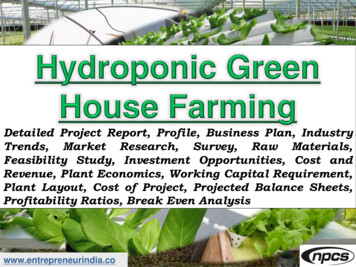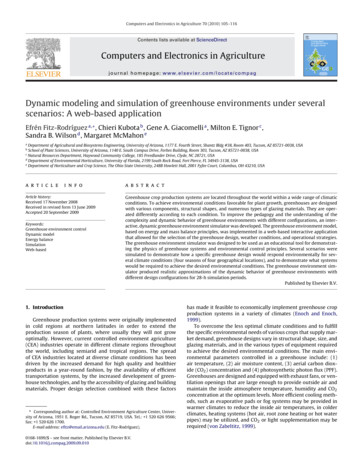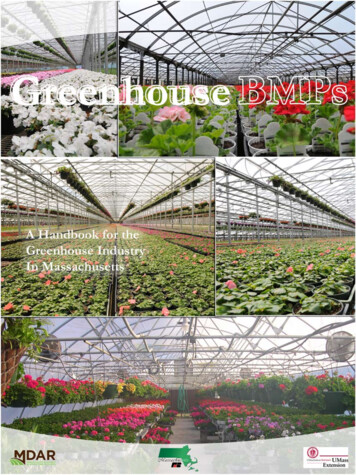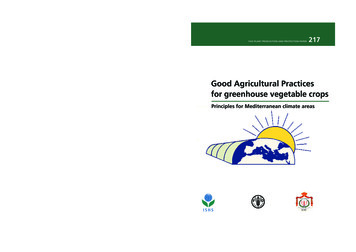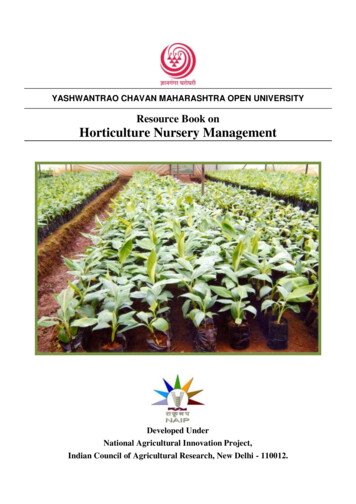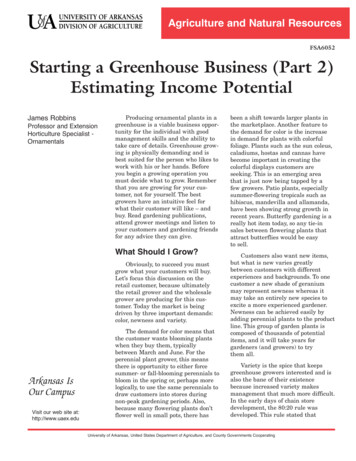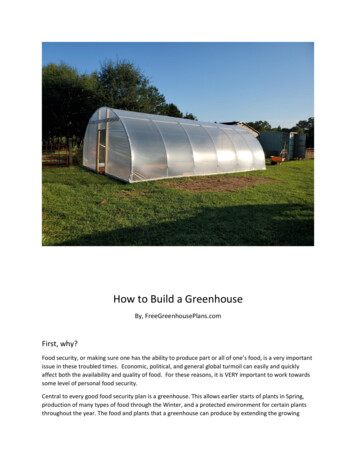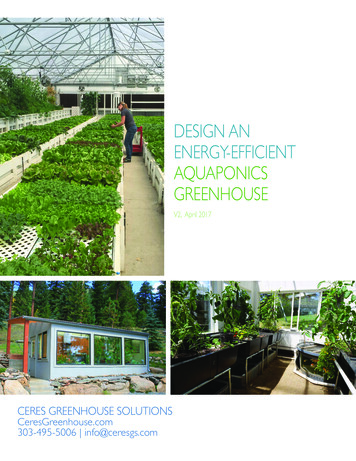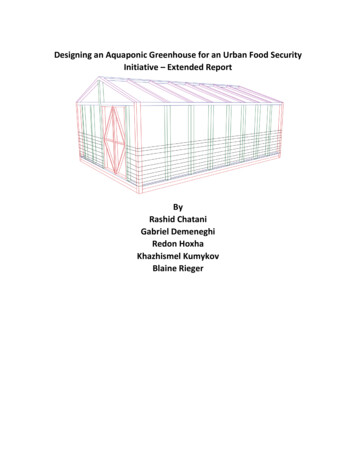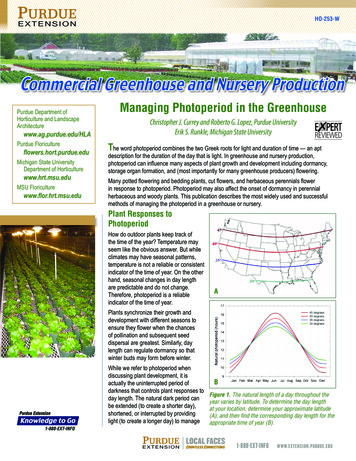
Transcription
HO-253-WAGRICULTUREEXTENSIONCommercial Greenhouse and Nursery ProductionPurdue Department ofHorticulture and LandscapeArchitecturewww.ag.purdue.edu/HLAPurdue Floricultureflowers.hort.purdue.eduMichigan State UniversityDepartment of Horticulturewww.hrt.msu.eduMSU Floriculturewww.flor.hrt.msu.eduManaging Photoperiod in the GreenhouseChristopher J. Currey and Roberto G. Lopez, Purdue UniversityErik S. Runkle, Michigan State UniversityThe word photoperiod combines the two Greek roots for light and duration of time — an aptdescription for the duration of the day that is light. In greenhouse and nursery production,photoperiod can influence many aspects of plant growth and development including dormancy,storage organ formation, and (most importantly for many greenhouse producers) flowering.Many potted flowering and bedding plants, cut flowers, and herbaceous perennials flowerin response to photoperiod. Photoperiod may also affect the onset of dormancy in perennialherbaceous and woody plants. This publication describes the most widely used and successfulmethods of managing the photoperiod in a greenhouse or nursery.Plant Responses toPhotoperiodHow do outdoor plants keep track ofthe time of the year? Temperature mayseem like the obvious answer. But whileclimates may have seasonal patterns,temperature is not a reliable or consistentindicator of the time of year. On the otherhand, seasonal changes in day lengthare predictable and do not change.Therefore, photoperiod is a reliableindicator of the time of year.APlants synchronize their growth anddevelopment with different seasons toensure they flower when the chancesof pollination and subsequent seeddispersal are greatest. Similarly, daylength can regulate dormancy so thatwinter buds may form before winter.While we refer to photoperiod whendiscussing plant development, it isactually the uninterrupted period ofdarkness that controls plant responses today length. The natural dark period canbe extended (to create a shorter day),shortened, or interrupted by providinglight (to create a longer day) to manageEXTENSIONAGRICULTUREBFigure 1. The natural length of a day throughout theyear varies by latitude. To determine the day lengthat your location, determine your approximate latitude(A), and then find the corresponding day length for theappropriate time of year (B).LOCAL FACESCOUNTLESS CONNECTIONS1-888-EXT-INFOWWW.EXTENSION.PURDUE.EDU
AGRICULTUREEXTENSIONHO-253-WManaging Photoperiod in the Greenhouse2photoperiodic plant responses such as flowering. Formost floriculture crops, a short day (SD) occurs whenthe night is at least 12 hours. For many long-day (LD)crops, a long day occurs when the night is less than10 hours, although this varies among species.More information about the induction of floweringusing photoperiod is available in CommericalGreenhouse and Nursery Production: FlowerInduction of Annuals (Purdue Extension publicationHO-249-W), available from The Education Store(www.the-education-store.com), and on the MichiganState University Floriculture Managing GreenhouseLight page (www.flor.hrt.msu.edu/lighting).Figure 2. This automatic blackout cloth curtainsystem encloses an individual bench.Natural PhotoperiodOutside the greenhouse, the natural photoperiodchanges throughout the year depending on thelocation. In the northern hemisphere, day lengthincreases between December 21 (the shortestday) until June 21 (the longest day), after whichit decreases. Seasonal fluctuation in day lengthbecomes more dramatic as the latitude increases(Figure 1).For example, the day length in New Orleans (30 N latitude) ranges from approximately 11 hours toa little more than 14 ½ hours. Meanwhile, the daylength in Minneapolis (45 N latitude) ranges from9 ½ to 16 hours. Because plants can perceive lowlight intensities, the natural (or biological) day lengthis approximately 30 to 40 minutes longer than theperiod from sunrise to sunset, depending on cloudcover, time of year, and location.To determine your natural photoperiod, firstdetermine your day length using the local timesfor sunrise and sunset. Next, add approximately30 to 40 minutes to account for civil twilight. Usingour previous examples, the natural photoperiod onDecember 21 would be about 11.5 hours in NewOrleans and 10 hours in Minneapolis.Creating Artificial Short DaysWhen the natural day length is long, there is only oneway to create a short photoperiod in the greenhouse:use an opaque material that does not allow lightto penetrate, which is commonly referred to as“black cloth” or “blackout cloth.” You can pull blackcloth over plants manually at a specified time in theafternoon (usually following the workday) to truncatethe natural day length. You can also install automaticblackout curtain systems that can enclose individualFigure 3. This blackout cloth curtain system enclosesan entire greenhouse.Figure 4. A blackout cloth made from synthetic blackfabric with a reflective exterior that has been manuallypulled over plants.benches or an entire greenhouse (Figures 2 and3). Then, retract the cloth at a specified time in themorning to expose plants to light again.Blackout cloths are generally made from syntheticblack fabric (Figure 4) or plastic (Figure 5). Syntheticfabrics with reflective outer surfaces can bedesirable because they reflect light and minimizeheat build-up underneath the material. Black plastic
AGRICULTUREEXTENSIONHO-253-W3Managing Photoperiod in the Greenhouseusing a black cloth that has a reflective outer layerthat reflects light (instead of just blocking it), therebyreducing radiant energy absorption from sunlight.Figure 5. A blackout cloth made from plastic that hasbeen manually pulled over a bench.Second, you can alter the time for closing andretracting the black cloth. For instance, you can pullthe black cloth over plants near or after sunset andretract it later in the morning. This avoids the heatof the late afternoon sun from building up underthe black cloth and extends the dark period intothe morning, when the greenhouse environment iscooler. Alternatively, you can open the black clothwhen it is completely dark outside and release theheat. Then, at least 30 minutes before sunrise, pullthe black cloth over the plants again to delay theonset of the photoperiod.Creating Artificial Long DaysIf your goal is to create an LD, you may useday-extension (DE) or night interruption (NI)photoperiodic lighting. Each method has advantagesand disadvantages, but generally, they are similarlyeffective. Both methods require you to deliver atleast 10 foot-candles (f.c.) or 2 μmol·m 2·s 1 of lightwhen measured at plant level.DE lighting is the practice of delivering light to extendthe length of the natural day. The length of time youlight will depend on the period of darkness the plantrequires and the natural day length. For example, ifthe natural day length is 9 hours and you desire a14-hour photoperiod, you would operate the lightsbeginning at sunset for about 5 ½ hours (an extrahalf hour for “insurance” against sunset/dusk).Figure 6. This boom-mounted high-intensity lampoperates during the night to provide intermittent lightto the crops below.is not widely used because it is not durable and ittraps heat and condensation, which can cause theplastic to collapse on top of the plants. However,black plastic may be useful when you need to provideshort days to a small number of plants (Figure 5).Blackout cloths can lead to problems. Plants that arerepeatedly exposed to high night temperatures (forexample, greater than 75 F) can develop heat delay.This common physiological disorder delays flowering.Heat delay is most often reported with poinsettia andchrysanthemum.There are a few strategies to avoid raisingtemperatures underneath black cloth. First, considerNI lighting is the practice of providing low-intensitylight to plants during the middle of the night. Byinterrupting the dark period, the plant will notperceive a long night, but a short night (or long day)instead. NI lighting is typically delivered during themiddle of night (such as from 10 p.m. to 2 a.m.),because plants are most sensitive to light atthis time.Typically, four hours of lighting is sufficient forplants that demonstrate an LD response. Somecrops respond to shorter (2-3 hours) durations.Most growers provide continuous light during the NIprocess to ensure a long day response. However,continuous light during the NI is not absolutelynecessary for plants to perceive a long day.Cyclic (intermittent) lighting is an alternative lightingstrategy that can reduce energy costs. Cyclicallighting involves using periodic lighting in the
AGRICULTUREEXTENSION4HO-253-Wmiddle of the night, such as light on for 5 minutesevery 20 minutes during a 4-hour period. Generallyspeaking, plants need to receive at least 10 f.c. ( 2µmol·m 2·s 1) for a minimum of 5 minutes everyhalf hour. This may reduce the overall amount ofenergy required to elicit an LD response by up to 83percent, although in some crops, flowering is delayedcompared to plants under continuous 4-hour lighting.Cyclic lighting may be provided several ways: First, use timers to turn lamps on and off, howeverthis technique is not recommended for highintensity discharge (HID) lamps — such as highpressure sodium (HPS) or metal halide lamps —because these lights have a relatively long ignitingperiod, and on/off cycles can reduce bulb life. Second, HPS or other HID lamps may be mountedon a boom that moves over the canopy for atleast 4 hours per night (Figure 6). Little researchhas been conducted with this boom lighting,AManaging Photoperiod in the Greenhousebut growers have reported successful results.Generally, program the booms so that plantsreceive light at least once every 20 minutes. Inaddition, the suggested intensity is higher, typicallyat least 50 f.c., although some crops likely respondto lower light levels. Third, a fairly new type of HPS lamp with anoscillating reflector/luminaire provides light toplants intermittently from a stationary light source(Figure 7). This lamp casts a beam of light tocrops below, and a 600-watt fixture can lightapproximately 1,500 square feet of greenhousespace if it can be placed high enough (at least 8feet if possible) above crops.Using a low-output light source — such as anincandescent (INC), screw-in light-emitting diodes(LED), or compact fluorescent bulbs (CFLs) — orusing cyclic lighting from an HID lamp, provides anegligible amount of photosynthetic light. However,when HID lamps are used to extend days, thedaily light integral may increase, depending on theduration and intensity of light used. While there arebenefits of supplemental or photosynthetic light, theywill not be discussed here. For more information, seeCommerical Greenhouse and Nursery Production:Measuring Daily Light Integral in a Greenhouse(Purdue Extension publication HO-238-W), andMeasuring Daily Light Integral (DLI) (HO-238-B-W),available from The Education Store, www.theeducation-store.com.Lamp Types/Light SourcesTo create NI or DE conditions, a grower hasseveral choices. Some of these choices, plus theiradvantages and limitations, are:BFigure 7. High-pressure sodium lamps withoscillating reflectors (A) cast moving beams of light tocrops below (B). Incandescent (INC) bulbs. These are commonlyused in greenhouses to provide DE and/or NIlighting (Figure 8). INC lights may be used forcyclic lighting, because the frequent on-and off willnot affect bulb life or fixture longevity. INC bulbsare inexpensive and emit an effective spectrum,but they are very energy inefficient and requirehigh power availability. Screw-in CFLs pose anattractive alternative to traditional INC lamps forDE and NI lighting. While CFLs are more energyefficient and are effective for use on many crops,their spectrum is not as effective at controllingflowering of some LD plants. CFLs are low in farred (FR) light, which is required for rapid floweringof some LD crops like pansy and petunia. It is
AGRICULTUREEXTENSIONHO-253-W5Managing Photoperiod in the Greenhousepossible to alternate CFL with INC bulbs to providethe required light quality for effective photoperiodiclighting and still achieve some energy savings(Figure 9). High-intensity discharge (HID) lamps. HIDlamps, such as metal halide and HPS lamps, mayalso be used effectively. There are several waysto use these lamps to provide DE and NI lighting.Most commonly, HPS lamps are suspendedabove the canopy. Another method is to mountHPS lamps on booms that move over the canopy(Figure 6). The newest development in HPS lampsis to use an oscillating reflector (Figure 7).Figure 8. Incandescent bulbs are effective at providinglong days, but they consume a lot of energy and arebeing phased out of production. Light-emitting Diodes (LEDs). This technologyis an emerging light source with promising plantapplications, including the regulation of flowering.Their long lifespan, energy efficiency, and abilityto target specific wavelengths of light make thema viable option for managing photoperiod. LEDsalso provide the opportunity to adjust the ratioof red (R) and far-red (FR) light for desired plantresponses. A low R/FR ratio promotes stemelongation in many plant species, which is ashade avoidance strategy plants developed frombeing shaded by neighboring plants. The bestcombination of R/FR and red/ blue is still beingstudied, but we do know that FR light is importantin promoting flowering in LD plants. Early studiesshow that LEDs that emit both R and FR lightare similarly effective as INC lamps. However,more research is needed on a wide variety ofornamental plants.ConclusionsManaging the photoperiod is an important aspectof greenhouse environmental management. Byunderstanding the natural photoperiod and thetechniques used to manipulate photoperiod, youcan achieve desired plant responses, such asaccelerated flowering to reach target market datesmore reliably.Figure 9. Alternating compact fluorescent bulbs withincandescent lamps can save on energy costs yet stillpromote flowering in a wide range of long-day plants.
HO-253-WAGRICULTUREEXTENSION6Managing Photoperiod in the GreenhouseReferencesBlanchard, M. and E. Runkle. 2009. Manipulatinglight in the greenhouse. Greenhouse Product News19 (6): 22-27.Boyle, T.H. 2010. Photoperiod control systems forgreenhouse crops. 16 Sep. 2010. www.umass.edu/umext/floriculture/fact sheets/greenhouse management/photo.html.Padhye, S. and E. Runkle. 2009. Providing long-dayswith CFLs. GrowerTalks 72 (11): 58-62.Runkle, E. 2002. Grower 101: Controlling photoperiod. Greenhouse Product News 12 (10): 90-93.Runkle, E. 2007. Technically speaking: Providing longdays. Greenhouse Product News 11 (1): 66.To see other publications in this series, visitthe Purdue Extension Education Store,www.the-education-store.com.Reference in this publication to any specificcommercial product, process, or service, or the useof any trade, firm, or corporation name is for generalinformational purposes only and does not constitutean endorsement, recommendation, or certificationof any kind by Purdue Extension. Individuals usingsuch products assume responsibility for theiruse in accordance with current directions of themanufacturer.Feb. 2013It is the policy of the Purdue University Cooperative Extension Service that all persons have equal opportunity and access to its educational programs, services, activities, andfacilities without regard to race, religion, color, sex, age, national origin or ancestry, marital status, parental status, sexual orientation, disability or status as a veteran.Purdue University is an Affirmative Action institution. This material may be available in alternative formats.EXTENSIONAGRICULTURELOCAL FACESCOUNTLESS CONNECTIONS1-888-EXT-INFO www.extension.purdue.eduOrder or download materials fromPurdue Extension The Education Storewww.the-education-store.com
DE lighting is the practice of delivering light to extend the length of the natural day. The length of time you light will depend on the period of darkness the plant requires and the natural day length. For example, if the natural day length is 9 hours and you d

